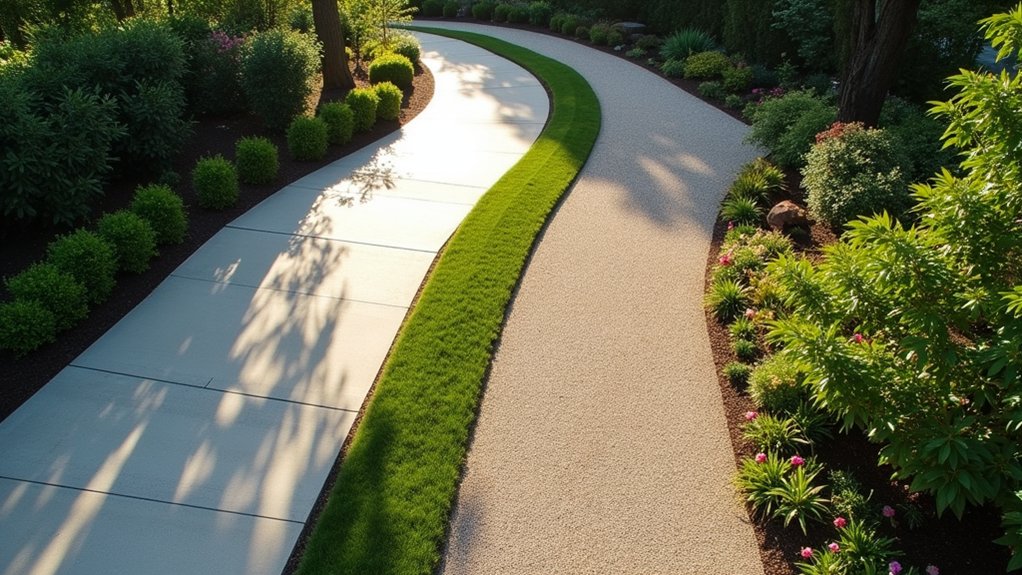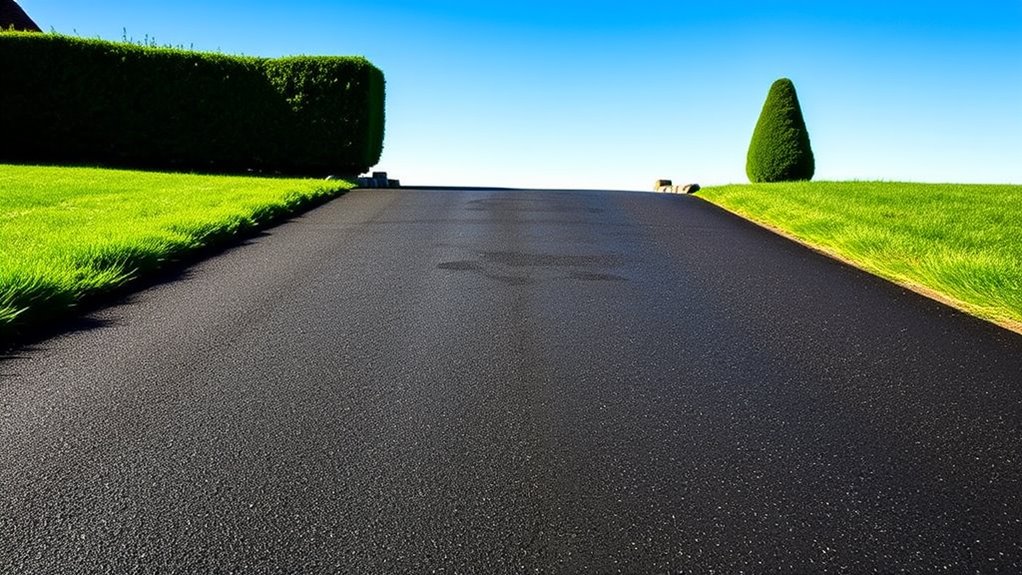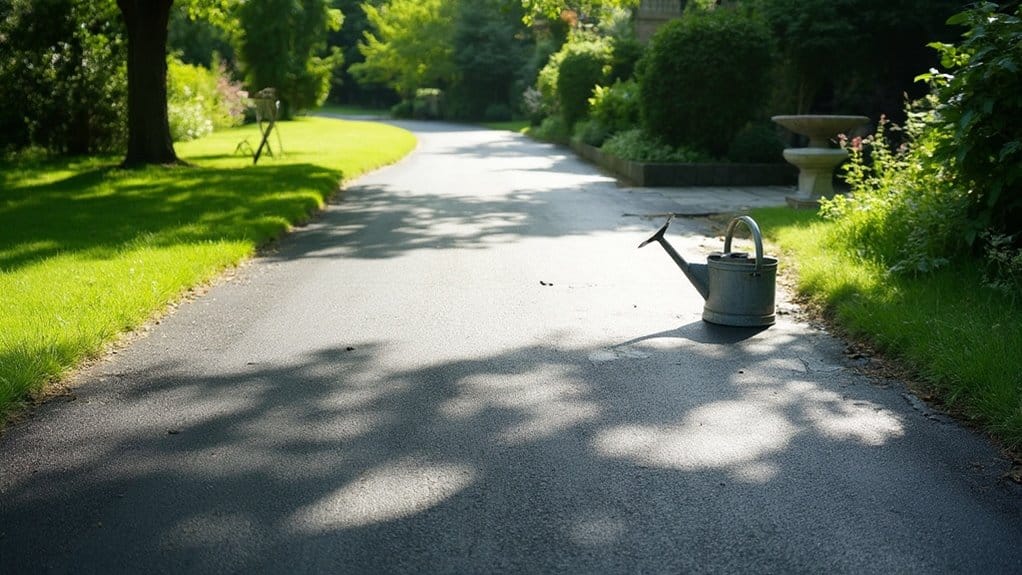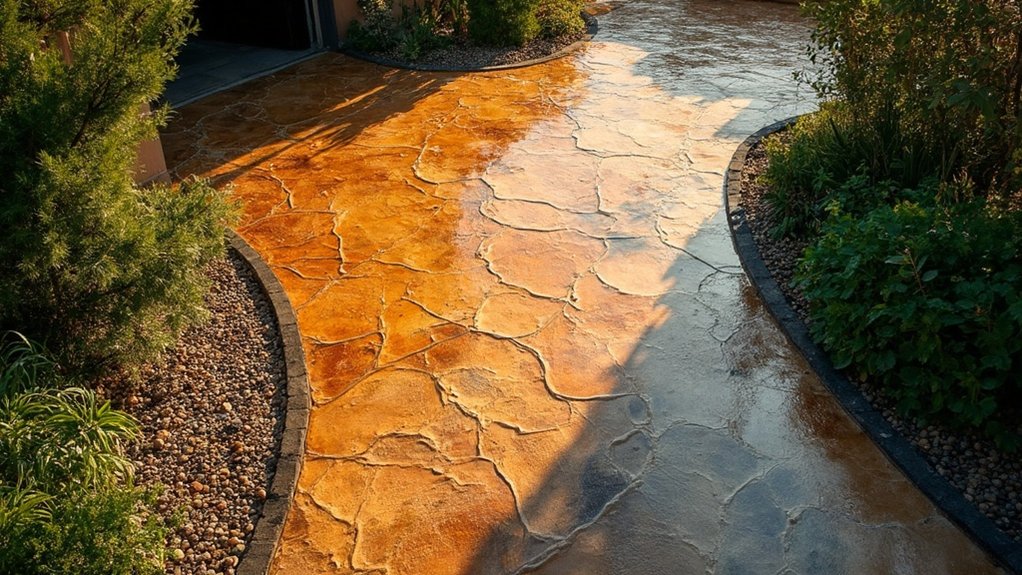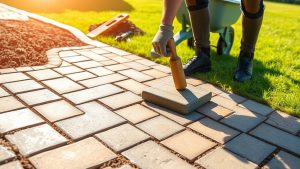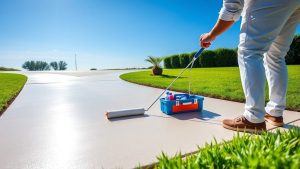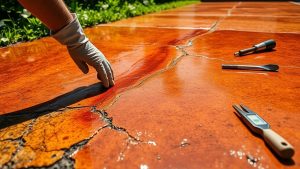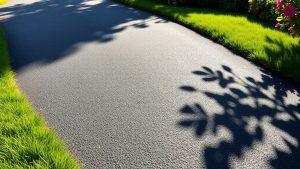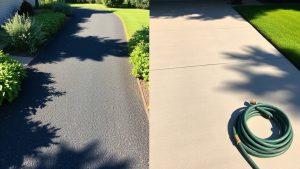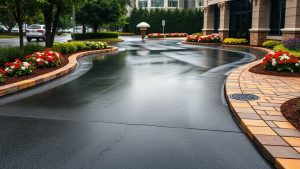Choosing the right driveway design for your property involves considering its size, layout, and future requirements. Think about materials such as tarmac or gravel for a budget-friendly option, or go for block paving or concrete for longevity.
When it comes to shape, straight driveways can save on space, while curved designs can add visual appeal. Keep traffic flow and parking capacity in mind to prevent congestion and ensure easy access.
Lastly, remember that your driveway design can significantly affect your home’s curb appeal. Take the time to explore these elements to make a choice that aligns with your property and lifestyle.
Table of Contents
ToggleKey Takeaways
- Assess the size and layout of your property to determine the most practical driveway shape and space for vehicle movement.
- Select materials based on your budget, durability, and maintenance requirements to ensure lasting satisfaction and visual appeal.
- Check local planning regulations and your existing landscaping to inform the design process and ensure compliance.
- Think about future needs for parking and traffic flow to accommodate family growth and guests.
- Include design features that boost curb appeal while promoting sustainability and ease of upkeep.
Assessing Your Property’s Size and Layout

When assessing your property’s size and layout for a driveway design, it’s important to consider how these elements will affect your decisions. The dimensions of your property will determine how to best optimise the layout for functionality. For smaller properties, a straight driveway is often the most practical choice, while larger plots can support more attractive curved designs. Additionally, permeable surfaces can be a great option as they allow for water absorption, which can be beneficial in managing drainage. Take into account any terrain features, as slopes or changes in gradient can significantly influence the stability and safety of your driveway. Ensure there’s enough space for vehicles to manoeuvre comfortably, especially if you have larger vehicles. The location of your garage and any existing landscaping should also inform your design, balancing practicality with visual appeal while adhering to local zoning regulations. Additionally, ensure that your driveway meets the minimum width requirements for safe vehicle access and maneuverability.
Understanding Different Driveway Materials
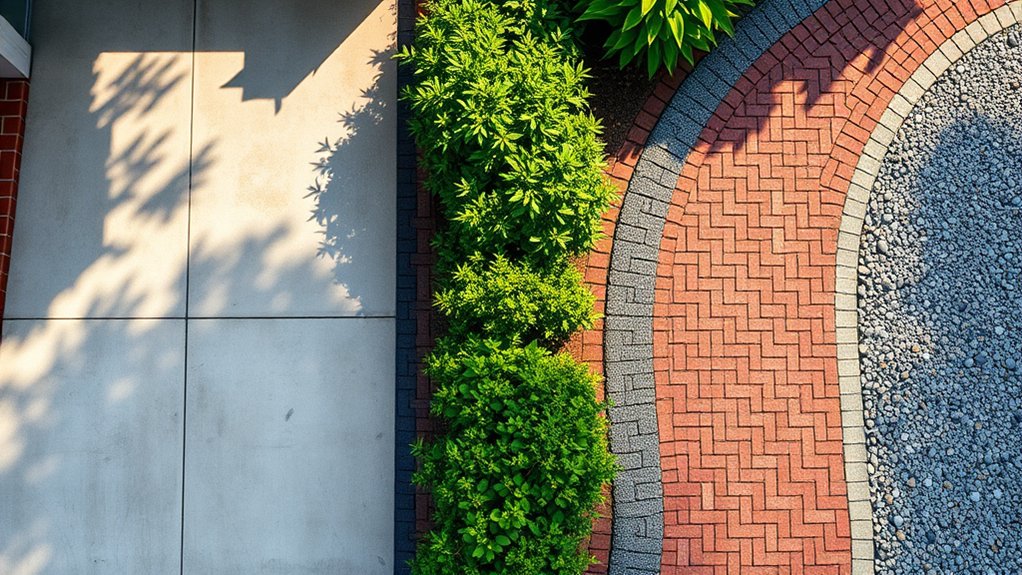
Once you’ve assessed the size and layout of your property, the next step is to choose the right materials for your driveway.
Asphalt is a cost-effective option with decent durability, but it does require quite a bit of maintenance. If you prefer a more polished look, concrete provides a sleek, modern appearance and can last for decades with less upkeep. Concrete’s lifespan can be as long as 50 years with proper care, making it a worthwhile investment for many homeowners. Additionally, choosing a durable material can help minimize long-term maintenance costs.
Gravel is another appealing choice; it’s affordable, quick to install, and the sound of gravel underfoot can deter intruders. However, it does need regular maintenance to manage weeds and prevent ruts.
For a traditional feel, consider block paving. Although it can be pricier, individual blocks can be easily replaced, and it offers a visually attractive finish.
Ultimately, select a material that fits your budget, aesthetic preferences, and maintenance capacity.
Evaluating Driveway Shapes for Functionality
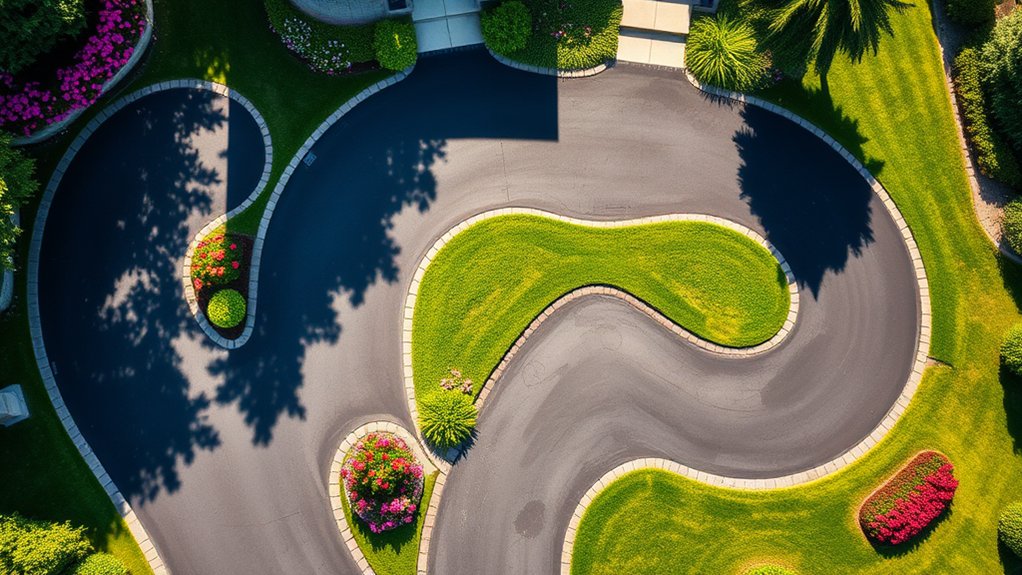
When choosing the right driveway shape for your home, it’s important to consider how it fits with your property’s layout and your lifestyle.
Straight driveways are space-efficient and cost-effective, making them perfect for narrower properties. Additionally, increased driveway space can provide more room for parking vehicles, accommodating guests comfortably. Using materials like tarmac can enhance durability and longevity.
L-shaped designs can increase parking capacity without detracting from your garden’s appeal.
If visual charm is your goal, curved driveways offer an attractive option with potential for lovely landscaping.
For larger properties, circular driveways facilitate easy access and allow for smooth manoeuvring of several vehicles.
If your land has unique features, think about S-shaped or custom driveways that suit steep slopes or reflect your personal style.
Ultimately, ensure the driveway orientation serves your needs and complements your home’s design.
Prioritizing Traffic Flow and Parking Needs
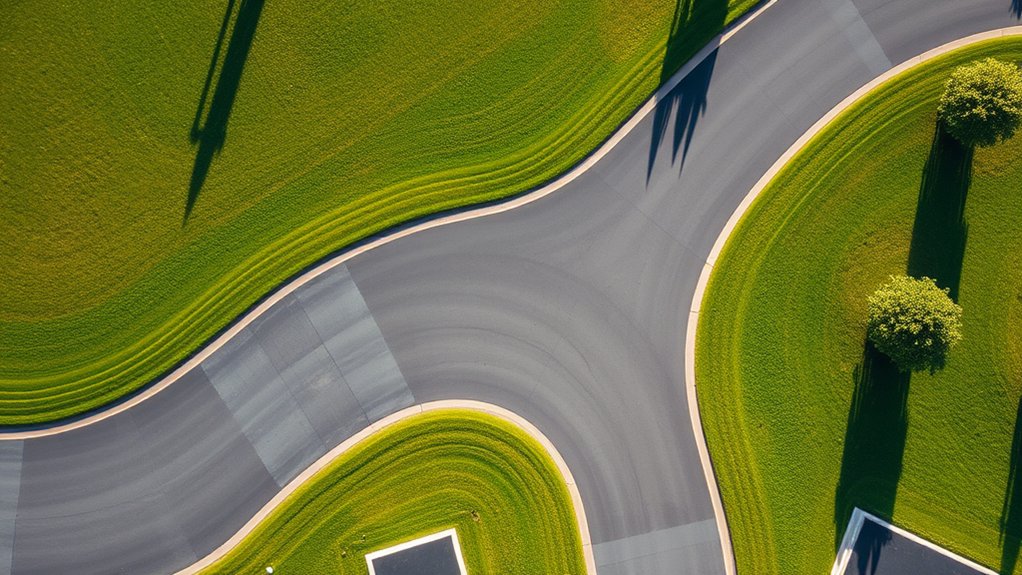
When designing your driveway, it’s crucial to consider vehicle movement patterns to ensure smooth traffic flow.
Assessing parking capacity is important to prevent congestion, and optimising entry and exit points will enhance efficiency.
For example, if you frequently have visitors, ensure there’s enough space for them to park without blocking your own vehicle.
Assess Vehicle Movement Patterns
To create an efficient driveway, it’s essential to assess vehicle movement patterns, as they significantly impact traffic flow and parking needs.
Understanding the interaction between inbound and outbound traffic can enhance the overall experience. Here are key factors to consider:
- Analyse peak hour traffic to effectively distribute vehicles.
- Observe driver behaviour; most will opt for the closest driveway.
- Consider congestion patterns—drivers may look for alternative routes during busy periods.
- Anticipate future growth to accommodate changing traffic volumes.
- Use traffic flow models to predict and manage vehicle movements.
Evaluate Parking Capacity
Assessing parking capacity is vital for making the most of your driveway and ensuring smooth traffic flow. Begin by evaluating your vehicle requirements and familiarising yourself with local parking regulations. Take traffic patterns into account to create a layout that facilitates easy vehicle movement. Here are some layout options to consider:
| Parking Type | Benefits |
|---|---|
| Angle Parking | Boosts capacity, reduces congestion |
| Parallel Parking | Optimises space in tight driveways |
| Perpendicular Parking | Fits more vehicles in the space |
| Compact Parking | Maximises capacity for smaller cars |
| Barrier-Free Design | Ensures accessibility for all users |
Select a layout that balances space efficiency with adherence to regulations, enhancing your property’s functionality.
Optimize Entry and Exit
Once you’ve established adequate parking capacity, it’s crucial to optimise how vehicles enter and exit your driveway to ensure smooth traffic flow.
Here are some important factors to consider:
- Traffic Volume: Assess the level of traffic to determine the right width and design for your driveway.
- Entry Angles: Choose appropriate entry angles to allow for easy access and prevent congestion.
- Exit Lane Design: Ensure the exit lane can accommodate larger vehicles and allows for safe departures.
- Surface Materials: Opt for materials that provide good traction and require minimal upkeep.
- Landscaping Visibility: Incorporate landscaping that enhances visibility for both drivers and pedestrians, promoting safety and accessibility.
Enhancing Aesthetic Appeal With Design Choices
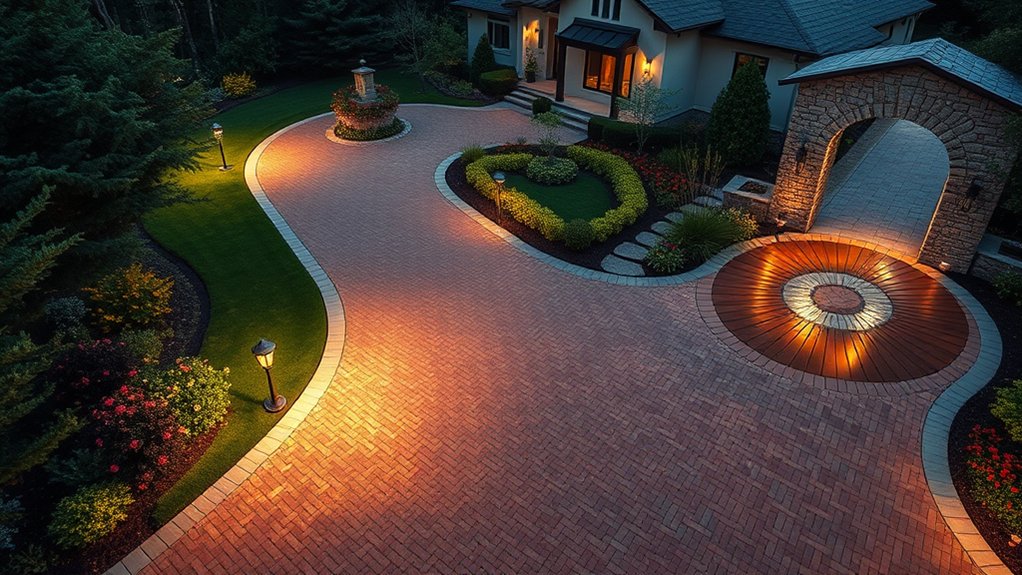
To enhance the aesthetic appeal of your driveway, the design choices you make can significantly transform the look of your property.
Choosing paver patterns offers creative customisation, allowing you to align the driveway with your home’s architecture.
Think about the colour selection; shades can either complement or contrast with your house, adding depth to your landscape.
Incorporating textures and organic shapes can create visual interest, ensuring a seamless flow between the driveway and its surroundings.
For a contemporary touch, consider adding biophilic elements like greenery alongside the pavers, which boosts both beauty and environmental benefits.
Ultimately, these design choices not only enhance your driveway’s appearance but also promote sustainability and ease of maintenance.
Planning for Future Needs and Changes
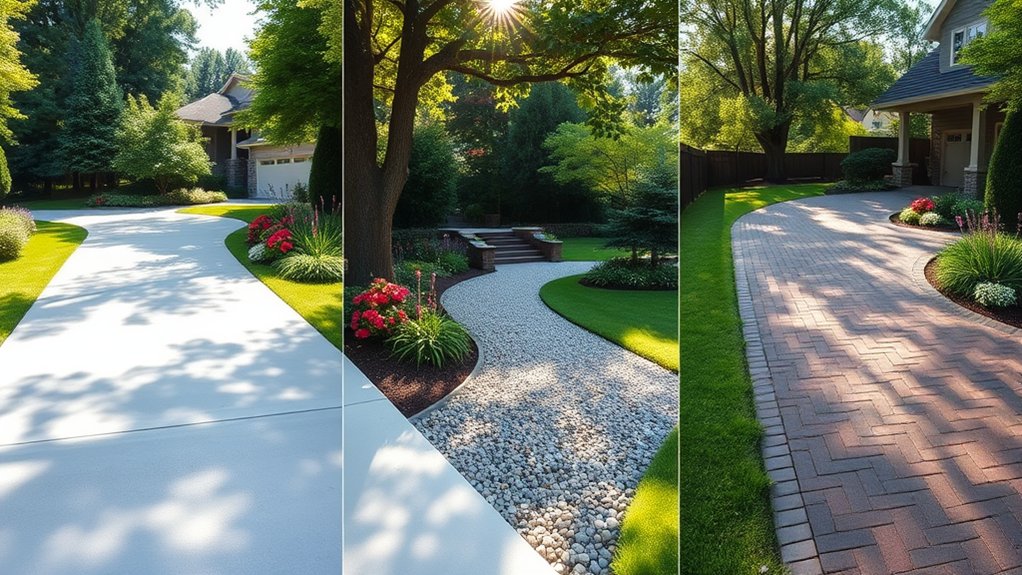
As your household changes, it’s important to consider how your driveway can adapt to future needs.
Employing flexible design strategies can significantly improve functionality. Here are some key points to think about:
- Anticipate the need for more vehicle space as your family grows or when hosting guests.
- Ensure the width allows for easy door openings and smooth manoeuvring.
- Plan for parking options for recreational vehicles, such as caravans, or bicycles.
- Design pedestrian pathways to ensure safety and accommodate increased foot traffic.
- Include effective drainage solutions to manage runoff from any expanded surfaces.
Estimating Your Driveway Budget
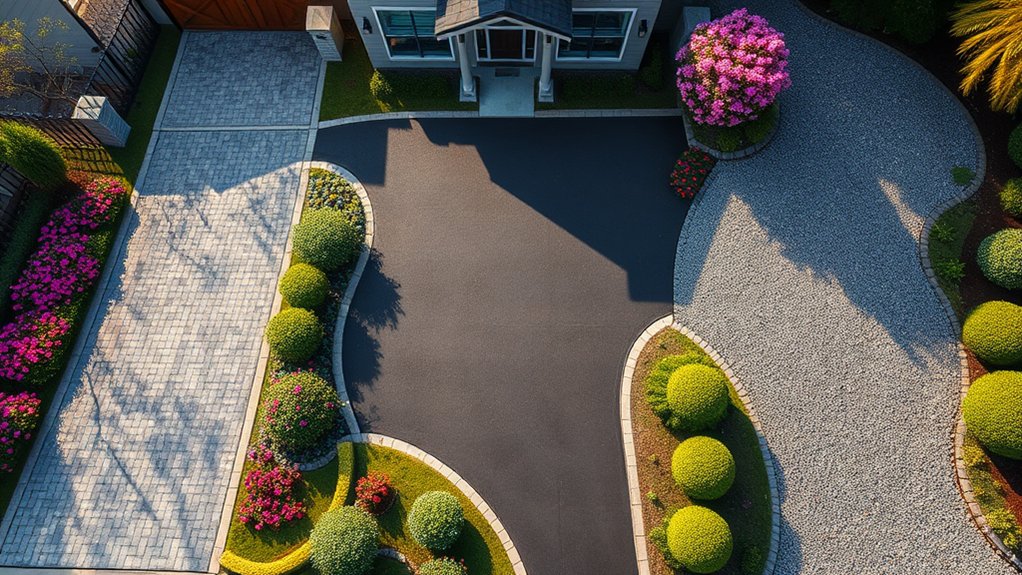
When estimating your driveway budget, it’s important to consider both material costs and installation fees.
Each material, from gravel to block paving, has its own price range, and labour costs can significantly affect your total.
Additionally, remember to account for long-term maintenance; what appears to be a good deal initially could result in higher costs in the future.
For example, while gravel may be cheaper to install, it often requires more upkeep than tarmacking.
Material Cost Considerations
Estimating your driveway budget requires an understanding of the material costs for various options. Here’s a concise breakdown to help you evaluate longevity and compare costs:
- Asphalt: £25 to £50 per square metre, lasting 15-20 years.
- Concrete: £30 to £65 per square metre, with a lifespan of over 25 years.
- Gravel: The most affordable at £10 to £25 per square metre, but less durable.
- Chip Seal: Between £15 to £40 per square metre, offering moderate durability.
- Pavers: £75 to £225 per square metre, highly durable but more expensive.
When budgeting for your driveway, consider the size, quality, design, location, and material availability to strike a balance between cost and longevity.
Installation and Maintenance Expenses
How can you ensure your driveway budget covers both installation and maintenance costs? Start by estimating your installation expenses, which can vary significantly depending on the material and size.
For instance, asphalt may cost around £30 per square metre, while labour fees can range from £20 to £50 per square metre. Don’t forget to include permits and any necessary demolition costs.
Once your driveway is in place, implement effective maintenance strategies to prolong its lifespan. Regular tasks, such as filling in cracks, can save you from expensive repairs later on.
On average, asphalt repairs might set you back between £900 and £3,500. By planning for both upfront and ongoing costs, you can ensure your driveway remains functional and visually appealing for many years.
Exploring the Benefits of a Well-Designed Driveway
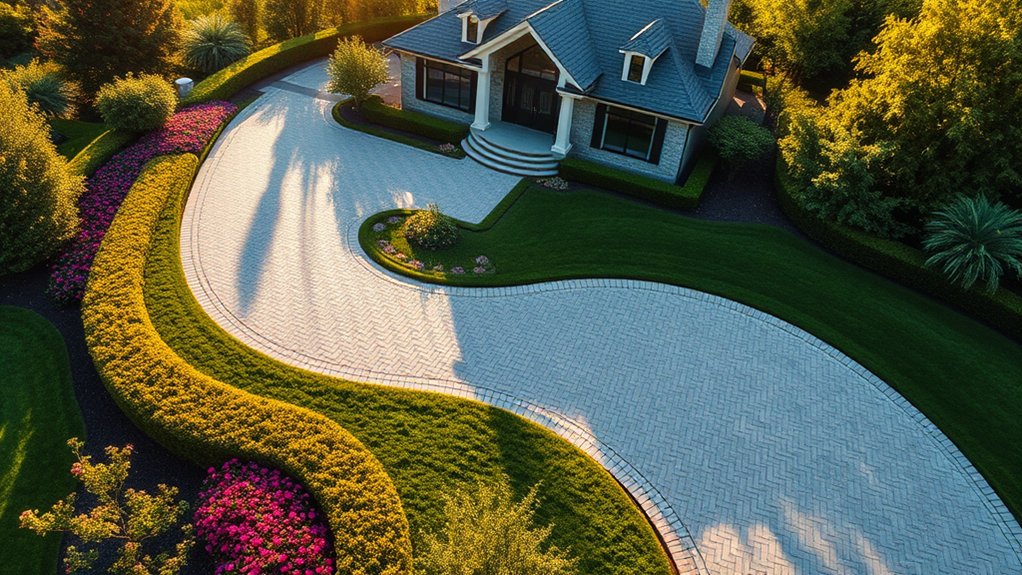
A well-designed driveway not only improves the look of your property but also increases its value and functionality.
By embracing modern design trends, you can enhance your driveway’s appeal while enjoying several benefits:
- Boosted property value through improved curb appeal.
- Increased safety and security, creating a secure space for vehicles.
- Eco-friendly options like permeable pavers, which help reduce environmental impact.
- Tailored designs that complement your property’s style.
- Quicker property sales, as potential buyers often prioritise well-constructed driveways.
Investing in a quality driveway elevates your property’s appearance and offers significant returns, making it a smart choice for homeowners looking to enhance both function and marketability.
Maintenance Tips for Longevity and Performance
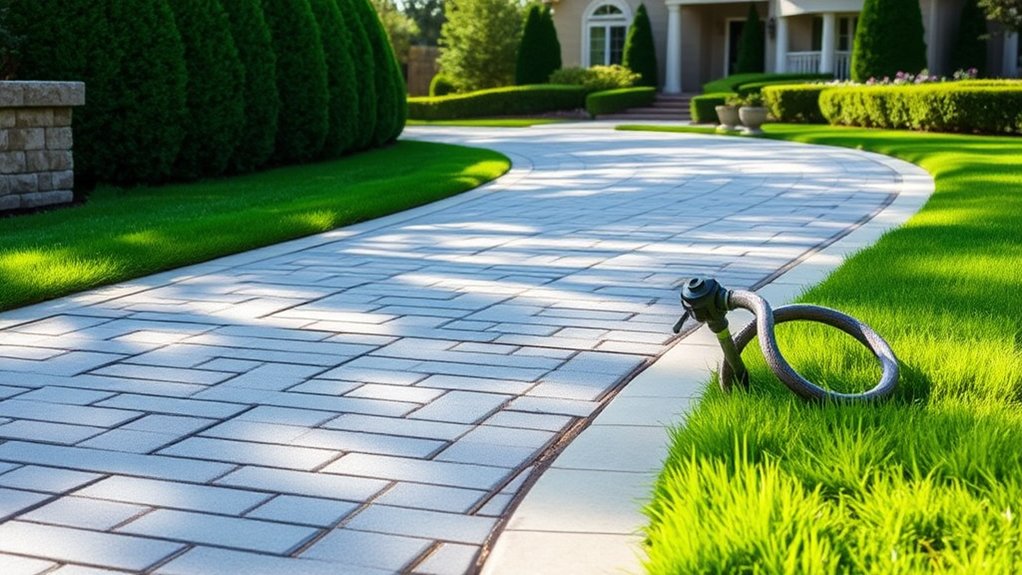
Although your driveway may enhance the overall look of your home, proper maintenance is crucial for ensuring its durability and functionality. Here are some straightforward maintenance tips to help your driveway last longer:
| Task | Frequency | Benefits |
|---|---|---|
| Regular Cleaning | Monthly | Prevents dirt and stains |
| Seal Coating | Annually (for concrete) | Protects against moisture |
| Crack Repair | As needed | Prevents further damage |
Be proactive by scheduling seasonal checks for cracks and ensuring proper drainage to avoid puddles. Using eco-friendly cleaning products not only safeguards your driveway but also benefits the environment. By prioritising these maintenance practices, you can extend the life of your driveway and keep it looking great.
Frequently Asked Questions
How Can I Improve My Driveway’s Curb Appeal?
To enhance your driveway’s curb appeal, concentrate on integrating landscaping and achieving colour harmony. Opt for pavers that match your home’s style, and incorporate plants and borders that add visual interest and create a unified appearance. For example, using gravel or patterned block paving can complement a traditional brick house beautifully.
What Driveway Design Fits Best With My Home’s Architecture?
Think of your home as a piece of music where modern and traditional elements need to work together. If your house has clean, straight lines, opt for a contemporary driveway design. For more classic homes, curved driveways can create a softer, inviting look. Choose a driveway that enhances your home’s character and adds to its overall appeal.
Are There Environmentally Friendly Driveway Materials Available?
Yes, there are several sustainable materials available for driveways. Consider permeable pavers, which allow water to soak through and help reduce surface runoff. Recycled asphalt is another great option, as it not only enhances drainage but also reuses existing materials. Grass pavers can also be an eco-friendly choice, promoting greenery while providing a sturdy surface. These materials make your driveway functional while being kind to the environment.
How Do Seasonal Changes Affect Driveway Maintenance?
Did you know that 70% of driveway damage occurs due to seasonal wear? To prevent this, follow these maintenance tips: regularly inspect for cracks and potholes, clear away leaves and debris, seal any cracks promptly, and power wash to keep your driveway looking its best. Taking these simple steps can help maintain your driveway’s integrity throughout the year.
Can I Install a Driveway Myself, or Should I Hire a Professional?
If you’re handy and willing to put in the work, you might consider installing your driveway yourself. However, hiring a professional can ensure quality results, compliance with local regulations, and a more efficient process. Think about the complexity of your project and your budget before making a decision. For example, if you’re laying block paving, it might be worth getting an expert to ensure it’s done correctly.
Conclusion
Choosing the right driveway design is essential for your property. It should complement your home’s character and serve practical purposes. Think about your available space, the materials you prefer, the shape of the driveway, and any future needs you might have. A well-designed driveway not only boosts curb appeal but also increases your home’s value. For instance, a gravel driveway may suit a rustic property, while a sleek block-paved option could match a modern home. Make a wise investment, and you’ll create a lasting impression that is both functional and attractive.
Optimize your tarmac driveway's appearance with simple maintenance tips, but discover the crucial secrets that can extend its lifespan even Read more
How to extend the life of your tarmac driveway starts with simple maintenance techniques that can lead to surprising results Read more
Just imagine transforming your driveway with stunning resin colors and finishes; discover the best options to elevate your home's curb Read more

